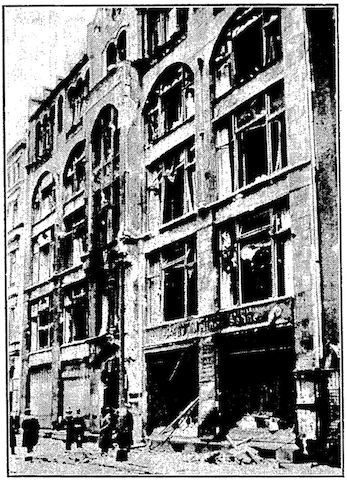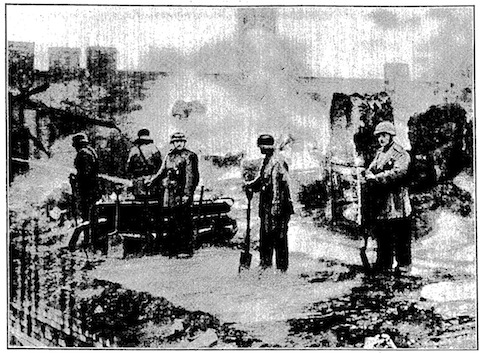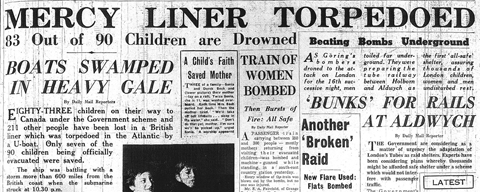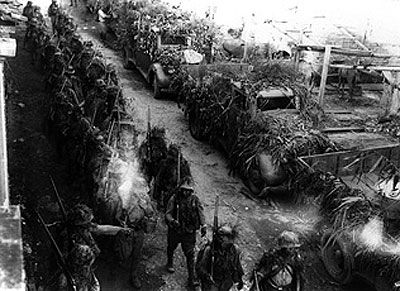Thursday 26 September 1940
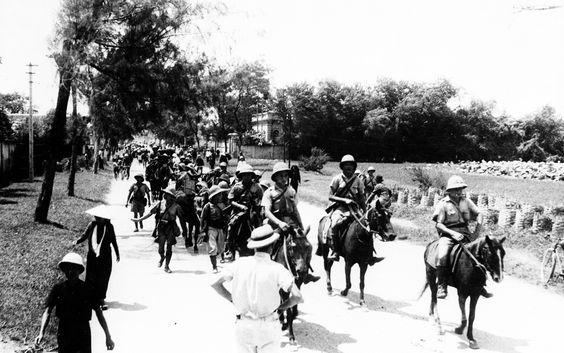 |
| French colonial forces retreat from Haiphong, in the Tonkin region of French Indochina, September 26, 1940. |
Battle of the Atlantic: Now that more U-boats are operating out of Norway and France, they are able to stalk convoys further out in the Atlantic. This area is not covered by air patrols at this stage of the war and escorts remain relatively rare. Attacking hundreds of miles out to sea is paying such handsome dividends that this period becomes known as the (first) "Happy Time" for U-boats.
For the crews of the convoys, though, every voyage is a lottery with death, as some ships get sunk with everyone surviving, and others with everyone perishing. It is not uncommon for merchant marine sailors to try to join the Royal Navy because sailing on freighters is so risky, while naval ships have better protection and aren't such easy targets.
There are several large convoys at sea, and they take a beating today.
U-46 (Kapitänleutnant Engelbert Endrass), operating out of St. Nazaire, France, is on patrol about 350 miles southwest of Ireland. It torpedoes 862-ton British freighter Coast Wings at 01:53. All 16 crewmen perish.
U-46 then torpedoes and sinks 3058-ton Swedish collier Siljan (formerly the Pilton) at 09:20. The ship goes down within 10 minutes. There are 18 survivors and 9 crew perish. The U-boat sustains some damage during the encounter and has to return to base early. There are three lifeboats from the ship: one is found by a French fishing boat; the second drifts at sea for several days before making landfall in Ireland; the third lifeboat is is never heard of again. That is the lottery of the convoys, plain and simple.
U-32 (Kapitänleutnant Hans Jenisch), operating about 400 miles west of Ireland, stalks Convoy OB 217. This U-boat also has a big day.
U=32, at 02:34, torpedoes and badly damages 6863-ton British freighter Corrientes. The crew abandons the ship and is picked up by another freighter, the Kosnaren.
U-32 then torpedoes and sinks 6904-ton Norwegian freighter Tancred at 08:11. All 36 crew take to lifeboats and spend 24 hours at sea before being rescued by Norwegian freighter Tricolor.
U-32 continues its long and productive day and, at 13:37, torpedoes and sinks 4084-ton British freighter Darcoila. All 31 crew perish.
U-137 (Kapitänleutnant Herbert Wohlfarth), on its first patrol operating out of Stavanger, stalks Convoy OB 218 about 10 miles north of Mullet Peninsula, Ireland. At 00:50, it begins launching three torpedoes.
U-137 torpedoes and sinks 6042-ton British freighter Manchester Brigade. There are four survivors, and 52-58 men perish (including 8 Royal Navy sailors, sources are unclear how many men were on board).
U-137 torpedoes and damages 4917-ton British freighter Ashantian (Master Charles C. Taylor). Four crew perish when the torpedo hits the engine room on the port side, the other 38 crew, 7 passengers, and 2 gunners take to one lifeboat (the other one swamps but is later recovered). The survivors spend the night thinking their ship was sunk and they were alone in the middle of the Atlantic, but when dawn comes they see the ship still afloat and reboard it. The crew uses the wireless to radio RAF aircraft observing the scene, and HMS Gloxinia (Lt. Cdr. A.J.C. Pomeroy, RNVR) comes by and takes them off. Trawler HMT Wolves then stops by and its crew boards the Ashantian. They manage to bring the ship to an anchorage just off the coast of Ireland. The ship is later towed to Kames Bay by Royal Navy tugs HMS Seaman and Superman and beached, where the Ashantian can be repaired. The Master of the Ashantian later complains that the men of the Wolves looted the ship as they brought it to Ireland.
U-137 continues stalking Convoy OB 218 and at 01:37 torpedoes and sinks 4753-ton British freighter Stratford. There are 32 survivors and 2 crew perish.
U-137 may also have sunk another ship today, the 1308 ton Norwegian freighter Asgerd. However, a Luftwaffe Focke Wulf Fw 200 Kondor may have sunk it, or at least participated in the sinking. It is unclear exactly what happened because all 17 men aboard perished.
The Luftwaffe does get a definite kill. Korps-Führ. Kette X.Fl.Korps Lf.5 bombs and badly damages 8043-ton British freighter Port Denison northeast of Aberdeen in the North Sea. The ship has been with OA 220 and sinks the next day. 16 men perish; there are survivors, but it is unclear how many - in these types of incidents, accurate records are not always available.
British submarines do not have as many tempting targets. They continue to lie in wait on the transit routes to and from the new U-boat bases in France and Norway, hoping to pick off some U-boats that have let their guard down. Today, HMS Tribune spots newly commissioned U-138 (Oberleutnant zur See Wolfgang Lüth) returning from its successful patrol (it sank four ships) and launches four torpedoes. All four miss and U-138 proceeds back to port to great acclaim.
German raider Thor is operating about 400 miles north of Brazil when it spots Norwegian whaling factory ship Kosmos. It takes the 89-man crew prisoner and then sinks the valuable ship with its deck gun. Captain Otto Kähler decides that the ship, which carries 17,000 tons of whale oil, would have too much difficulty making it back to France, but such a valuable cargo would have been welcome back home.
Royal Navy destroyer HMS Veteran is damaged by a mine as it returns to Harwich from the abortive Operation Lucid (the fireship operation). The damage, however, is not too serious. British freighters Welsh Prince and Suva also take some damage in the same attack, while British freighters Diplomat and Peterton are damaged at Brunswick Dock in Liverpool and freighter West Kedron and tug Wellington near Liverpool.
Convoys OA 220 and FS 292 depart from Methil, Convoy FN 291 departs from Southend, Convoy HX 76 departs from Halifax, Convoy BHX 76 departs from Bermuda.
Royal Navy corvette HMS Nasturtium (K 107) is commissioned.
Battle of Britain: The Spitfire factory at Filton remains out of operation due to the big raids on the 25th. This is as much due to all the skilled workers last as from the damage to the facility itself. The government has recognized the danger to the large factories and begun to disperse valuable machine tools to other areas.
The renewed Luftwaffe priority on British aircraft factories continues today. Around 09:00, the Luftwaffe sends over a large formation of about 180 planes from the Calais area. Fighter Command mobilizes No. 11 and 12 Groups, and they blunt the attack. However, some bombers do get through to central and western London.
Around noontime, the Luftwaffe sends over an even bigger raid. This time, about 300 planes head toward the Chatham area. Fighter Command makes another maximum effort, sending up 20 squadrons. Another, smaller raid around the same time targets the Filton area again. RAF Filton takes the damage this time, with damage to the Operations Room but no serious problems caused.
King George visits RAF Northolt in the afternoon, and while he is there RAF No. 1 (Canadian) and 303 (Polish) Squadrons are scrambled. They head to intercept a raid approaching over the Isle of Wight region. This time, there are about 60 aircraft heading to the Southampton Supermarine Works. This attack is tremendously destructive, with three Spitfires destroyed on the production line. The Luftwaffe bombing is inaccurate, but that works to its benefit as some bombs strike the nearby Dawks gas works and docks. Over 100 people are killed in this attack and many more are wounded. Fighter Command mounts a moderate response, and much of the action involves anti-aircraft guns trying to bring down raiders. The bombers take moderate losses, losing a few over the area and having a couple of Heinkel He 11s barely make it back to base.
After dark, the usual raids begin against London, Liverpool, and other cities. The Luftwaffe also targets RAF Mildenhall and Duxford. The raids continue intermittently all night. They damage railway infrastructure throughout the London area, and a couple of bombs barely miss the Houses of Parliament. The underground Cabinet War Room is rattled when a bomb falls nearby. In Liverpool, incendiaries set fires in the dockyard areas.
The score for the day is even, with both sides losing about nine planes. The RAF engages in some wild overclaiming of the sort last seen in August by a factor of over 10, which of course the media picks up to trumpet British successes. It, in fact, is a very successful day for the Luftwaffe, though their actual bombing achievements are localized and not as significant as they might appear at first glance. However, a lot of civilian lives are lost today despite the low aircraft losses on both sides, and there is nothing insignificant about that.
Hptm. Helmut Wick of Stab I./JG 2 notches his 30th victory claim. Numerous Luftwaffe pilots claim double victories, so there appears to be some overclaiming on that side, too. It is common on all sides in all wars.
European Air Operations: Bomber Command raids the Channel ports as the Germans gradually disperse their invasion barges. Other targets include Kiel and airfields in northwest Europe. The RAF mounts a "special mission" by twelve Hampdens of No. 61 Squadron primarily against German battlecruiser Scharnhorst in Kiel Harbor, but no hits are achieved and one bomber is lost.
Battle of the Mediterranean: The RAF sends two different strikes against Italian forces at Sallum along the border. It is a potential choke point for Italian communications back to Fort Capuzzo and Tobruk, and Marshal Graziani is preoccupied with his supply lines.
At Malta, Governor Dobbie continues to complain to the War Office about the lack of regular mail service. Otherwise, it is a quiet day on the island.
German/Japanese Relations: In one of the key meetings of the pre-war (for the Pacific) period, the Japanese Privy Council discusses the proposed alliance with Italy and Germany, The agreement is still not a done deal despite German Foreign Minister Ribbentrop's assumption in Berlin that it is. The meeting, which includes the military and pretty much everyone else of influence, is told that the Emperor will issue an Imperial Rescript which endorses the pact, but also notes:
The meeting reaches a somewhat convoluted conclusion: an alliance with Germany and Japan would prevent a war with the United States by demonstrating Japan's resolve. Ambassador Kurusu in Berlin is instructed to sign the pact, which he does the next day, but Italian Foreign Minister Ciano notes that nobody in Berlin is very excited about the event. The same holds true in Tokyo.
It is important to recognize that the pact (which forms what comes to be known as the Axis, as opposed to the previous "Pact of Steel" between Germany and Italy) obligates the contracting parties to "assist one another with all political, economic and military means when one of the three Contracting Parties is attacked." It does not obligate anything when one of the Contracting Parties attacks someone else. The Japanese demonstrate that they fully understand this key distinction by their inaction on 22 June 1941, the Germans - or at least Adolf Hitler - not so much about six months later.
US/Latin American Relations: Pursuant to the Pittman Act passed on 16 June 1940, the Roosevelt administration authorizes the Export-Import Bank to lend Latin American governments up to $500 million and for them to purchase up to $400 in arms and munitions. All of this is designed, per the act's purpose, to strengthen the defenses of the Western Hemisphere.
US/Japanese Relations: Coincidental with the Japanese discussions today about US economic warfare, the Roosevelt administration today decides to impose a ban on US exports of scrap iron and steel beyond the Western Hemisphere (with the key exception of Great Britain). This ban is scheduled to take effect on 16 October 1940.
Anglo/Finnish Relations: The British lodge a diplomatic protest at the Finnish government's decision to grant the Wehrmacht transit rights.
German Military: Grand Admiral Erich Raeder meets with Adolf Hitler and pushes the idea of a peripheral strategy against Great Britain that focuses on the Mediterranean. He advocates seizing Gibraltar, the Canary Islands, and the Azores. These ideas remain on the docket for a long time, but in practice would require the cooperation (or subjugation) of Spain and Portugal - neither of which is forthcoming.
French Indochina: The Japanese land at Dong Tac, south of the port of Haiphong, and invest the port. A second landing a little later brings ashore a dozen tanks and swells the number of Japanese soldiers to 4500. In addition, Japanese bombers attack the French troops in the port, which take some casualties. The Japanese take the port either today or on the 27th and station 900 troops in Haiphong.
In addition, the Japanese occupy the railway yards at Phu Lang Thuong and Lao Cai, and also the Gia Lam airfield near Hanoi. The Japanese station 600 troops in Hanoi.
The Vichy government essentially has capitulated by this point, and the Japanese invasion is complete except for some loose ends. The French agree that the Japanese can garrison 40,000 troops in southern Indochina (the Saigon/Mekong Delta region), but the Japanese remain primarily in the north. At this point, the Japanese are not really worried about the French, but they tread lightly for fear of antagonizing the British who maintain strong presences at Hong Kong and Singapore, the Dutch who also have powerful naval forces to the south in Indonesia, and, worst of all, the United States.
Below is a Getty slideshow of the Japanese capture of Haiphong, 26 July 1940.
Australia: With many Australian servicemen either in the Middle East already or on the way, the media takes a keen interest in the Battle of the Mediterranean. The Sydney Morning Herald publishes an editorial that notes that the Axis has experienced a "loss of initiative" there, and Malta, in particular, is a sign of Axis defeat.
British Homefront: Henry Willink, the Conservative Member of Parliament for Croydon, becomes Special Commissioner for the Homeless. While his title sounds extremely farsighted in a "Great Society" way, Willink simply is to organize aid services for people made homeless through enemy air raids.
September 1940
September 1, 1940: RAF's Horrible Weekend
September 2, 1940: German Troopship Sunk
September 3, 1940: Destroyers for Bases
September 4, 1940: Enter Antonescu
September 5, 1940: Stukas Over Malta
September 6, 1940: The Luftwaffe Peaks
September 7, 1940: The Blitz Begins
September 8, 1940: Codeword Cromwell
September 9, 1940: Italians Attack Egypt
September 10, 1940: Hitler Postpones Sealion
September 11, 1940: British Confusion at Gibraltar
September 12, 1940: Warsaw Ghetto Approved
September 13, 1940: Zeros Attack!
September 14, 1940: The Draft Is Back
September 15, 1940: Battle of Britain Day
September 16, 1940: Italians Take Sidi Barrani
September 17, 1940: Sealion Kaputt
September 18, 1940: City of Benares Incident
September 19, 1940: Disperse the Barges
September 20, 1940: A Wolfpack Gathers
September 21, 1940: Wolfpack Strikes Convoy HX-72
September 22, 1940: Vietnam War Begins
September 23, 1940: Operation Menace Begins
September 24, 1940: Dakar Fights Back
September 25, 1940: Filton Raid
September 26, 1940: Axis Time
September 27, 1940: Graveney Marsh Battle
September 28, 1940: Radio Belgique Begins
September 29, 1940: Brocklesby Collision
September 30, 1940: Operation Lena
2020
For the crews of the convoys, though, every voyage is a lottery with death, as some ships get sunk with everyone surviving, and others with everyone perishing. It is not uncommon for merchant marine sailors to try to join the Royal Navy because sailing on freighters is so risky, while naval ships have better protection and aren't such easy targets.
There are several large convoys at sea, and they take a beating today.
U-46 (Kapitänleutnant Engelbert Endrass), operating out of St. Nazaire, France, is on patrol about 350 miles southwest of Ireland. It torpedoes 862-ton British freighter Coast Wings at 01:53. All 16 crewmen perish.
U-46 then torpedoes and sinks 3058-ton Swedish collier Siljan (formerly the Pilton) at 09:20. The ship goes down within 10 minutes. There are 18 survivors and 9 crew perish. The U-boat sustains some damage during the encounter and has to return to base early. There are three lifeboats from the ship: one is found by a French fishing boat; the second drifts at sea for several days before making landfall in Ireland; the third lifeboat is is never heard of again. That is the lottery of the convoys, plain and simple.
U-32 (Kapitänleutnant Hans Jenisch), operating about 400 miles west of Ireland, stalks Convoy OB 217. This U-boat also has a big day.
U=32, at 02:34, torpedoes and badly damages 6863-ton British freighter Corrientes. The crew abandons the ship and is picked up by another freighter, the Kosnaren.
U-32 then torpedoes and sinks 6904-ton Norwegian freighter Tancred at 08:11. All 36 crew take to lifeboats and spend 24 hours at sea before being rescued by Norwegian freighter Tricolor.
U-32 continues its long and productive day and, at 13:37, torpedoes and sinks 4084-ton British freighter Darcoila. All 31 crew perish.
U-137 (Kapitänleutnant Herbert Wohlfarth), on its first patrol operating out of Stavanger, stalks Convoy OB 218 about 10 miles north of Mullet Peninsula, Ireland. At 00:50, it begins launching three torpedoes.
U-137 torpedoes and sinks 6042-ton British freighter Manchester Brigade. There are four survivors, and 52-58 men perish (including 8 Royal Navy sailors, sources are unclear how many men were on board).
U-137 torpedoes and damages 4917-ton British freighter Ashantian (Master Charles C. Taylor). Four crew perish when the torpedo hits the engine room on the port side, the other 38 crew, 7 passengers, and 2 gunners take to one lifeboat (the other one swamps but is later recovered). The survivors spend the night thinking their ship was sunk and they were alone in the middle of the Atlantic, but when dawn comes they see the ship still afloat and reboard it. The crew uses the wireless to radio RAF aircraft observing the scene, and HMS Gloxinia (Lt. Cdr. A.J.C. Pomeroy, RNVR) comes by and takes them off. Trawler HMT Wolves then stops by and its crew boards the Ashantian. They manage to bring the ship to an anchorage just off the coast of Ireland. The ship is later towed to Kames Bay by Royal Navy tugs HMS Seaman and Superman and beached, where the Ashantian can be repaired. The Master of the Ashantian later complains that the men of the Wolves looted the ship as they brought it to Ireland.
U-137 continues stalking Convoy OB 218 and at 01:37 torpedoes and sinks 4753-ton British freighter Stratford. There are 32 survivors and 2 crew perish.
U-137 may also have sunk another ship today, the 1308 ton Norwegian freighter Asgerd. However, a Luftwaffe Focke Wulf Fw 200 Kondor may have sunk it, or at least participated in the sinking. It is unclear exactly what happened because all 17 men aboard perished.
The Luftwaffe does get a definite kill. Korps-Führ. Kette X.Fl.Korps Lf.5 bombs and badly damages 8043-ton British freighter Port Denison northeast of Aberdeen in the North Sea. The ship has been with OA 220 and sinks the next day. 16 men perish; there are survivors, but it is unclear how many - in these types of incidents, accurate records are not always available.
British submarines do not have as many tempting targets. They continue to lie in wait on the transit routes to and from the new U-boat bases in France and Norway, hoping to pick off some U-boats that have let their guard down. Today, HMS Tribune spots newly commissioned U-138 (Oberleutnant zur See Wolfgang Lüth) returning from its successful patrol (it sank four ships) and launches four torpedoes. All four miss and U-138 proceeds back to port to great acclaim.
German raider Thor is operating about 400 miles north of Brazil when it spots Norwegian whaling factory ship Kosmos. It takes the 89-man crew prisoner and then sinks the valuable ship with its deck gun. Captain Otto Kähler decides that the ship, which carries 17,000 tons of whale oil, would have too much difficulty making it back to France, but such a valuable cargo would have been welcome back home.
Royal Navy destroyer HMS Veteran is damaged by a mine as it returns to Harwich from the abortive Operation Lucid (the fireship operation). The damage, however, is not too serious. British freighters Welsh Prince and Suva also take some damage in the same attack, while British freighters Diplomat and Peterton are damaged at Brunswick Dock in Liverpool and freighter West Kedron and tug Wellington near Liverpool.
Convoys OA 220 and FS 292 depart from Methil, Convoy FN 291 departs from Southend, Convoy HX 76 departs from Halifax, Convoy BHX 76 departs from Bermuda.
Royal Navy corvette HMS Nasturtium (K 107) is commissioned.
 |
| U-32 (pre-war). |
The renewed Luftwaffe priority on British aircraft factories continues today. Around 09:00, the Luftwaffe sends over a large formation of about 180 planes from the Calais area. Fighter Command mobilizes No. 11 and 12 Groups, and they blunt the attack. However, some bombers do get through to central and western London.
Around noontime, the Luftwaffe sends over an even bigger raid. This time, about 300 planes head toward the Chatham area. Fighter Command makes another maximum effort, sending up 20 squadrons. Another, smaller raid around the same time targets the Filton area again. RAF Filton takes the damage this time, with damage to the Operations Room but no serious problems caused.
King George visits RAF Northolt in the afternoon, and while he is there RAF No. 1 (Canadian) and 303 (Polish) Squadrons are scrambled. They head to intercept a raid approaching over the Isle of Wight region. This time, there are about 60 aircraft heading to the Southampton Supermarine Works. This attack is tremendously destructive, with three Spitfires destroyed on the production line. The Luftwaffe bombing is inaccurate, but that works to its benefit as some bombs strike the nearby Dawks gas works and docks. Over 100 people are killed in this attack and many more are wounded. Fighter Command mounts a moderate response, and much of the action involves anti-aircraft guns trying to bring down raiders. The bombers take moderate losses, losing a few over the area and having a couple of Heinkel He 11s barely make it back to base.
After dark, the usual raids begin against London, Liverpool, and other cities. The Luftwaffe also targets RAF Mildenhall and Duxford. The raids continue intermittently all night. They damage railway infrastructure throughout the London area, and a couple of bombs barely miss the Houses of Parliament. The underground Cabinet War Room is rattled when a bomb falls nearby. In Liverpool, incendiaries set fires in the dockyard areas.
The score for the day is even, with both sides losing about nine planes. The RAF engages in some wild overclaiming of the sort last seen in August by a factor of over 10, which of course the media picks up to trumpet British successes. It, in fact, is a very successful day for the Luftwaffe, though their actual bombing achievements are localized and not as significant as they might appear at first glance. However, a lot of civilian lives are lost today despite the low aircraft losses on both sides, and there is nothing insignificant about that.
Hptm. Helmut Wick of Stab I./JG 2 notches his 30th victory claim. Numerous Luftwaffe pilots claim double victories, so there appears to be some overclaiming on that side, too. It is common on all sides in all wars.
European Air Operations: Bomber Command raids the Channel ports as the Germans gradually disperse their invasion barges. Other targets include Kiel and airfields in northwest Europe. The RAF mounts a "special mission" by twelve Hampdens of No. 61 Squadron primarily against German battlecruiser Scharnhorst in Kiel Harbor, but no hits are achieved and one bomber is lost.
Battle of the Mediterranean: The RAF sends two different strikes against Italian forces at Sallum along the border. It is a potential choke point for Italian communications back to Fort Capuzzo and Tobruk, and Marshal Graziani is preoccupied with his supply lines.
At Malta, Governor Dobbie continues to complain to the War Office about the lack of regular mail service. Otherwise, it is a quiet day on the island.
German/Japanese Relations: In one of the key meetings of the pre-war (for the Pacific) period, the Japanese Privy Council discusses the proposed alliance with Italy and Germany, The agreement is still not a done deal despite German Foreign Minister Ribbentrop's assumption in Berlin that it is. The meeting, which includes the military and pretty much everyone else of influence, is told that the Emperor will issue an Imperial Rescript which endorses the pact, but also notes:
We earnestly wish that war be ended and peace be restored as quickly as possible.This settles the matter of signing the treaty, but two issues remain under discussion:
- The American reaction;
- How this will affect Japanese oil supplies.
The meeting reaches a somewhat convoluted conclusion: an alliance with Germany and Japan would prevent a war with the United States by demonstrating Japan's resolve. Ambassador Kurusu in Berlin is instructed to sign the pact, which he does the next day, but Italian Foreign Minister Ciano notes that nobody in Berlin is very excited about the event. The same holds true in Tokyo.
It is important to recognize that the pact (which forms what comes to be known as the Axis, as opposed to the previous "Pact of Steel" between Germany and Italy) obligates the contracting parties to "assist one another with all political, economic and military means when one of the three Contracting Parties is attacked." It does not obligate anything when one of the Contracting Parties attacks someone else. The Japanese demonstrate that they fully understand this key distinction by their inaction on 22 June 1941, the Germans - or at least Adolf Hitler - not so much about six months later.
US/Latin American Relations: Pursuant to the Pittman Act passed on 16 June 1940, the Roosevelt administration authorizes the Export-Import Bank to lend Latin American governments up to $500 million and for them to purchase up to $400 in arms and munitions. All of this is designed, per the act's purpose, to strengthen the defenses of the Western Hemisphere.
US/Japanese Relations: Coincidental with the Japanese discussions today about US economic warfare, the Roosevelt administration today decides to impose a ban on US exports of scrap iron and steel beyond the Western Hemisphere (with the key exception of Great Britain). This ban is scheduled to take effect on 16 October 1940.
Anglo/Finnish Relations: The British lodge a diplomatic protest at the Finnish government's decision to grant the Wehrmacht transit rights.
German Military: Grand Admiral Erich Raeder meets with Adolf Hitler and pushes the idea of a peripheral strategy against Great Britain that focuses on the Mediterranean. He advocates seizing Gibraltar, the Canary Islands, and the Azores. These ideas remain on the docket for a long time, but in practice would require the cooperation (or subjugation) of Spain and Portugal - neither of which is forthcoming.
 |
| USS Gar (SS 206) in its construction frame, September 26, 1940. (Photo courtesy of The US Navy Submarine Force Museum.) |
In addition, the Japanese occupy the railway yards at Phu Lang Thuong and Lao Cai, and also the Gia Lam airfield near Hanoi. The Japanese station 600 troops in Hanoi.
The Vichy government essentially has capitulated by this point, and the Japanese invasion is complete except for some loose ends. The French agree that the Japanese can garrison 40,000 troops in southern Indochina (the Saigon/Mekong Delta region), but the Japanese remain primarily in the north. At this point, the Japanese are not really worried about the French, but they tread lightly for fear of antagonizing the British who maintain strong presences at Hong Kong and Singapore, the Dutch who also have powerful naval forces to the south in Indonesia, and, worst of all, the United States.
Below is a Getty slideshow of the Japanese capture of Haiphong, 26 July 1940.
Australia: With many Australian servicemen either in the Middle East already or on the way, the media takes a keen interest in the Battle of the Mediterranean. The Sydney Morning Herald publishes an editorial that notes that the Axis has experienced a "loss of initiative" there, and Malta, in particular, is a sign of Axis defeat.
British Homefront: Henry Willink, the Conservative Member of Parliament for Croydon, becomes Special Commissioner for the Homeless. While his title sounds extremely farsighted in a "Great Society" way, Willink simply is to organize aid services for people made homeless through enemy air raids.
September 1940
September 1, 1940: RAF's Horrible Weekend
September 2, 1940: German Troopship Sunk
September 3, 1940: Destroyers for Bases
September 4, 1940: Enter Antonescu
September 5, 1940: Stukas Over Malta
September 6, 1940: The Luftwaffe Peaks
September 7, 1940: The Blitz Begins
September 8, 1940: Codeword Cromwell
September 9, 1940: Italians Attack Egypt
September 10, 1940: Hitler Postpones Sealion
September 11, 1940: British Confusion at Gibraltar
September 12, 1940: Warsaw Ghetto Approved
September 13, 1940: Zeros Attack!
September 14, 1940: The Draft Is Back
September 15, 1940: Battle of Britain Day
September 16, 1940: Italians Take Sidi Barrani
September 17, 1940: Sealion Kaputt
September 18, 1940: City of Benares Incident
September 19, 1940: Disperse the Barges
September 20, 1940: A Wolfpack Gathers
September 21, 1940: Wolfpack Strikes Convoy HX-72
September 22, 1940: Vietnam War Begins
September 23, 1940: Operation Menace Begins
September 24, 1940: Dakar Fights Back
September 25, 1940: Filton Raid
September 26, 1940: Axis Time
September 27, 1940: Graveney Marsh Battle
September 28, 1940: Radio Belgique Begins
September 29, 1940: Brocklesby Collision
September 30, 1940: Operation Lena
2020



